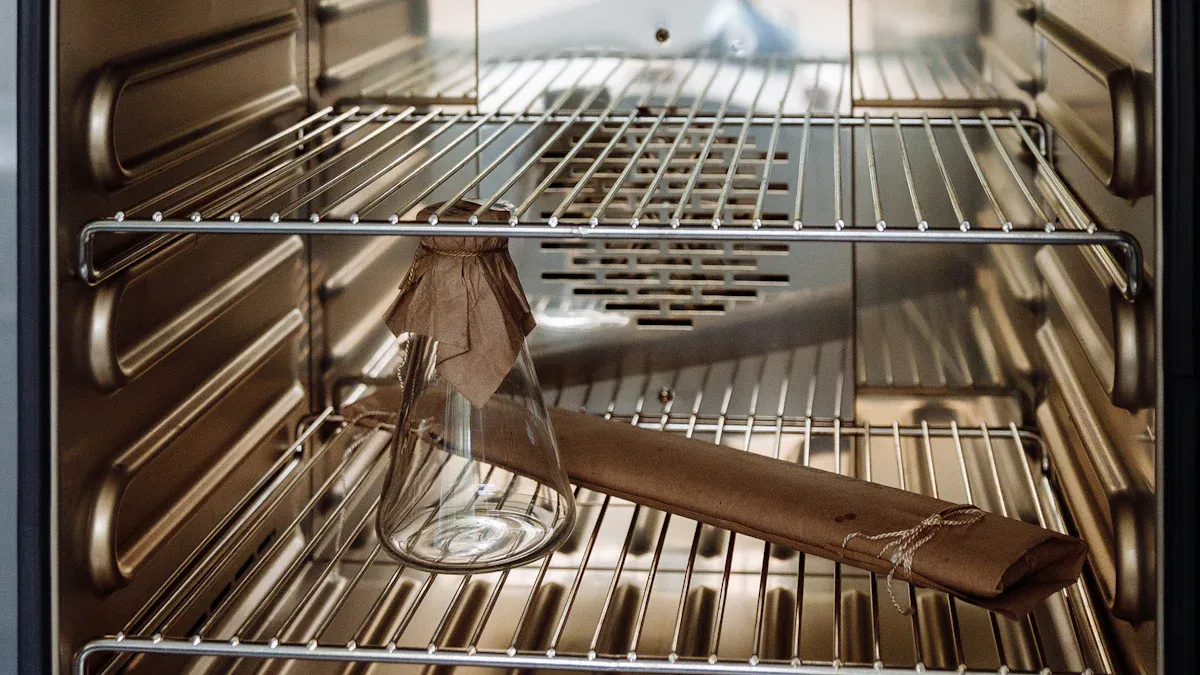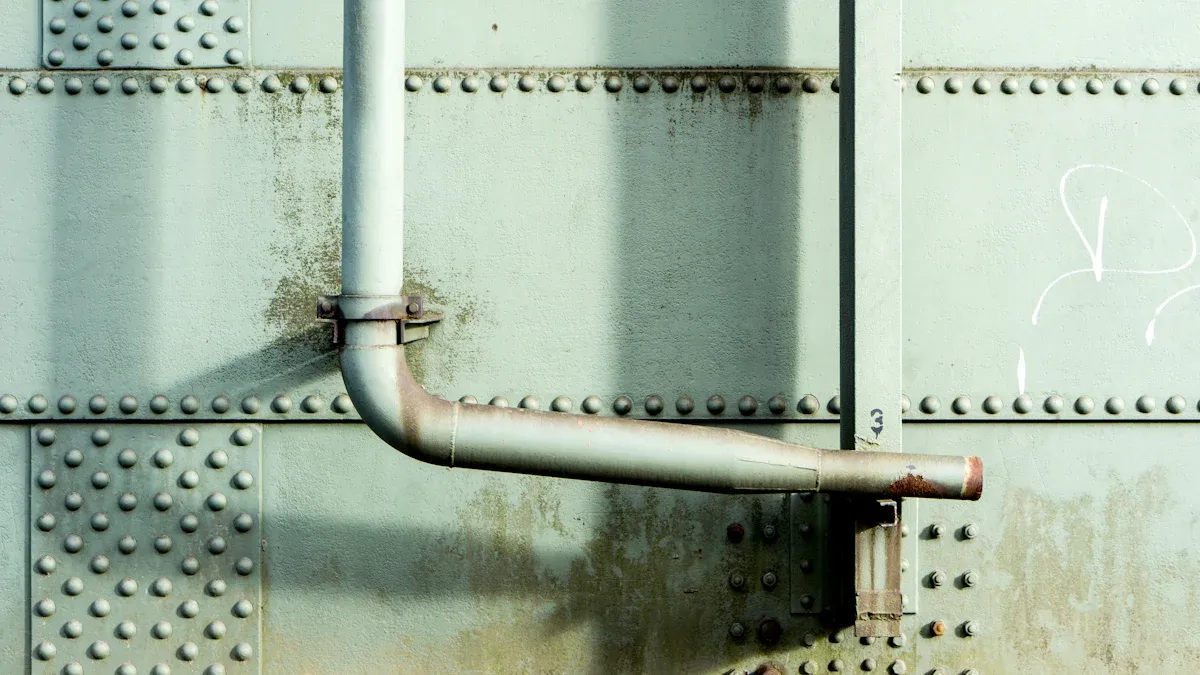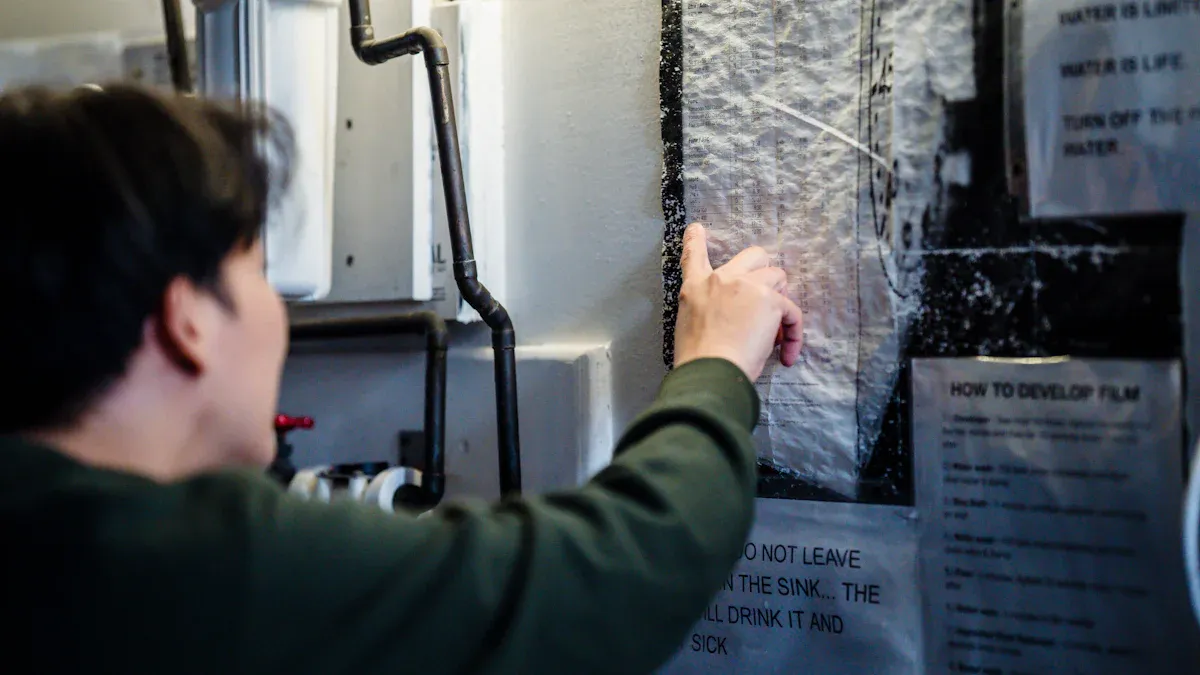
Many homeowners notice symptoms like lukewarm water, fluctuating temperatures, or strange noises from their water heater heating element. They might see leaks or even rising energy bills. Always turn off power before checking an immersion water heater. If a tankless water heater gas model acts up, replace the water heater element.
Key Takeaways
- Always turn off the power before inspecting or repairing the water heater to stay safe from electrical shocks.
- Use a multimeter to test the heating element and thermostat for proper function and replace faulty parts promptly to keep hot water flowing.
- Regularly flush the tank to remove sediment buildup, which protects the heating element, improves efficiency, and extends the water heater’s life.
Check Power Supply for Water Heater Heating Element

Ensure the water heater is receiving power
A water heater needs a steady power supply to work well. If someone finds cold water coming from the tap, they should check if the unit is getting electricity. Here are some steps to follow:
- Look at the installation. The water heater should be hardwired with the correct voltage, usually 240 volts. Plugging it into a regular outlet does not work.
- Inspect the wiring. Damaged or worn wires can stop power from reaching the unit.
- Use a multimeter. Set it to measure alternating voltage. Test the thermostat terminals. A reading close to 240 volts means power is reaching the thermostat.
- Test the heating element terminals with the multimeter. If the reading is also near 240 volts, power is reaching the Water Heater Heating Element.
Tip: Always turn off the power before touching any wires or terminals. This keeps everyone safe from electric shock.
Reset the circuit breaker if tripped
Sometimes, the water heater stops working because the circuit breaker has tripped. They should check the breaker box and look for the switch labeled “water heater.” If it is in the “off” position, flip it back to “on.” Press the red reset button inside the control panel if the unit has shut down. This can restore power after overheating or a power issue.
If the breaker trips again, there may be a bigger problem. In that case, it is best to call a professional for help.
Inspect and Test Water Heater Heating Element

Turn off power before inspection
Safety comes first when someone wants to inspect a Water Heater Heating Element. They should always turn off the power at the circuit breaker labeled for the water heater. This step helps prevent electrical shock. After switching off the breaker, they need to use a non-contact voltage tester to make sure no electricity flows to the unit. Wearing insulated gloves and safety glasses protects against hazards and debris. Keeping the workspace dry and removing jewelry or metal accessories also lowers the risk of accidents.
Tip: If anyone feels unsure about handling electrical parts, they should call a licensed professional. Manufacturers recommend following their instructions for locating access panels and handling wiring safely.
Here’s a quick checklist for safe inspection:
- Turn off power at the circuit breaker.
- Confirm power is off with a voltage tester.
- Wear insulated gloves and safety glasses.
- Keep the area dry and remove jewelry.
- Use screwdrivers to remove access panels carefully.
- Handle insulation gently and replace it after testing.
Use a multimeter to test for continuity
Testing the heating element with a multimeter helps find out if it works. First, they should disconnect the wires from the heating element terminals. Setting the multimeter to the continuity or ohms setting prepares it for the test. Touching the probes to the two screws on the element gives a reading. A beep or a resistance between 10 and 30 ohms means the element works. No reading or no beep means the element is faulty and needs replacement.
Here’s how to test for continuity:
- Disconnect wires from the heating element.
- Set the multimeter to continuity or ohms.
- Place probes on the element terminals.
- Listen for a beep or check for a reading between 10 and 30 ohms.
- Reattach wires and panels after testing.
Most heating elements last between 6 and 12 years. Regular inspection and testing can help catch problems early and extend the life of the unit.
Examine and Adjust Water Heater Heating Element Thermostat
Check thermostat settings
Many people forget to check the thermostat when their water heater acts up. The thermostat controls how hot the water gets. Most experts recommend setting the thermostat to 120°F (49°C). This temperature keeps water hot enough to kill bacteria like Legionella, but not so hot that it causes burns. It also helps save energy and lowers utility bills. Some families may need to adjust the setting if they use a lot of hot water or live in a cold area.
Tip: Setting the thermostat too high can cause overheating. Overheated water can trip the reset button and even damage the Water Heater Heating Element. Always use a thermometer to double-check the water temperature at the tap.
Test thermostat functionality
A faulty thermostat can cause many problems. People might notice water that is too hot, too cold, or changes temperature often. Sometimes, the high-limit reset switch trips again and again. This usually means the thermostat is not working right. Other signs include slow hot water recovery or running out of hot water quickly.
Here are some common thermostat issues:
- Inconsistent water temperature
- Overheating and scalding risk
- Slow hot water recovery
- Frequent tripping of the reset switch
To test the thermostat, turn off the power first. Remove the access panel and use a multimeter to check for continuity. If the thermostat does not work, it needs to be replaced. Keeping the thermostat at 120°F helps prevent overheating and extends the life of the heating element.
Look for Visible Signs of Damage on Water Heater Heating Element
Inspect for corrosion or burn marks
When someone checks their water heater, they should look closely at the heating element for any corrosion or burn marks. Corrosion often appears as rust or discoloration on the metal parts. Burn marks may look like dark spots or melted areas. These signs mean the element is struggling to work and might fail soon. Corrosion happens when minerals and water react with the metal, causing rust and sediment to build up. This layer of sediment acts like a blanket, making the element work harder and less efficiently. Over time, this can lead to overheating and even damage the tank lining.
If a person hears popping or hissing noises from the heater, that usually means sediment has built up on the element. Strange sounds are a warning sign that the element needs attention.
A quick inspection can help catch these problems early. Certified technicians recommend regular maintenance, such as flushing the tank and checking the anode rod, to prevent corrosion and keep the Water Heater Heating Element working safely.
Check for water leaks around the tank
Water leaks around the tank are another clear sign of trouble. If someone sees puddles or wet spots near the heater, they should act fast. Leaks often mean the heating element or the tank itself has corroded. Cloudy or rust-colored water coming from the tap can also point to corrosion inside the tank. Leaks can cause serious safety risks, including pressure buildup or even tank rupture.
- Lukewarm water that never gets hot
- Hot showers that suddenly turn cold
- Frequent tripping of the circuit breaker
- Cloudy or rust-colored water
- Strange noises from the heater
- Visible water puddles near the tank
Spotting these signs early helps prevent bigger problems and expensive repairs. Regular inspections and listening for unusual sounds can save money and keep the water heater running smoothly.
Flush the Tank to Protect Water Heater Heating Element
Drain the tank safely
Draining a water heater tank sounds tricky, but it becomes simple with the right steps. First, they should turn off the electricity or set the gas heater to pilot mode. Next, they need to shut off the cold water supply at the top of the tank. It helps to let the tank cool down before starting, so no one gets burned by hot water. After that, they can attach a garden hose to the drain valve at the bottom and run the hose to a safe spot, like a floor drain or outside.
Opening a hot water faucet in the house lets air in and helps the tank drain faster. Then, they can open the drain valve and let the water flow out. If the water looks cloudy or drains slowly, they can try turning the cold water supply on and off to break up any clogs. Once the tank is empty and the water runs clear, they should close the drain valve, remove the hose, and refill the tank by turning the cold water back on. When water flows steadily from the faucets, it’s safe to close them and restore power.
Tip: Always check the product manual before starting. If the tank is old or water does not drain, calling a professional is the safest choice.
Remove built-up sediment that can affect heating
Sediment builds up in water heater tanks over time, especially in areas with hard water. This sediment forms a layer at the bottom, making the heater work harder and less efficiently. People might hear popping or hissing sounds, notice less hot water, or see rust-colored water. These are signs that sediment is causing trouble.
Regular flushing helps prevent these problems. Most manufacturers recommend flushing the tank at least once a year. In places with hard water, doing this every four to six months works even better. Flushing removes mineral deposits, keeps the tank clean, and helps the heater last longer. It also stops the heating element from overheating and reduces the risk of leaks or tank failure.
Regular flushing keeps energy bills lower and hot water flowing strong. It also protects the pressure relief valve and other important parts.
Replace Faulty Water Heater Heating Element Components
Remove and replace a bad heating element
Sometimes, a water heater just does not heat like it used to. People might notice lukewarm water, no hot water at all, or hot water that runs out too fast. Other signs include water taking longer to heat, a tripped circuit breaker, or strange noises like popping and sizzling. These problems often mean the heating element needs to be replaced, especially if a multimeter test shows no or infinite ohms.
Here are the steps most manufacturers recommend for replacing a bad heating element:
- Turn off the power at the circuit breaker and check with a voltage tester.
- Shut off the cold water supply valve.
- Attach a garden hose to the drain valve and drain water below the element level.
- Remove the access panel and insulation.
- Disconnect wires from the heating element.
- Use a wrench to remove the old element.
- Clean the gasket area and install the new element with a new gasket.
- Reconnect the wires.
- Close the drain valve and turn on the cold water supply.
- Open a hot water faucet to let air out until water flows smoothly.
- Replace insulation and the access panel.
- Turn the power back on and test the water temperature.
Post time: Aug-15-2025




